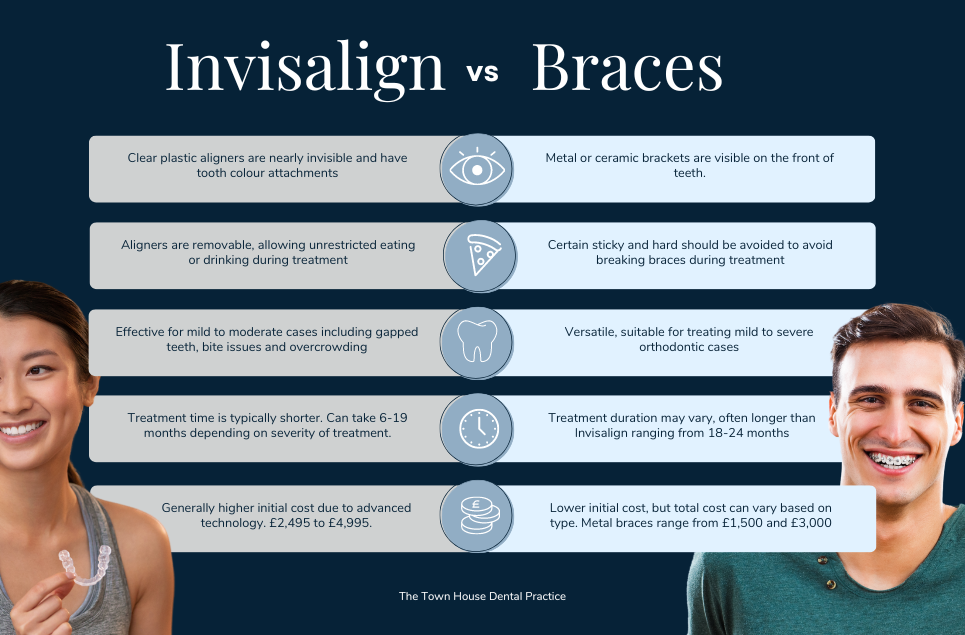
26th January 2024
The Pros & Cons: Invisalign Vs. Braces
Invisalign vs Braces, Which is Better?
Maintaining good dental health is vital for your overall well-being. But if your teeth are misaligned, it can cause speaking problems, affect your bite, and lead to jaw pain. All of the above can adversely affect your health.
Fixing misalignment through braces or Invisalign not only improves your smile but also helps improve your oral health. When it comes to fixing misaligned teeth, you have options. But how do you know whether Invisalign or braces are best for you?
The article below compares Invisalign to braces, including costs and treatment indications, to help you make an informed decision on which is best for you.

Overview of Invisalign

Invisalign is a type of clear aligner used for orthodontic treatment to correct wide spectrum of conditions including over crowding, bite issues and gapped teeth. The “aligner” is a clear, thin material custom-made for each individual. The process involves wearing a series of aligners over the teeth that gradually move them into the correct position. Usually, you switch aligners every week or two.
Although Invisalign is not completely invisible, it is clear and less noticeable than traditional braces. Many people may choose Invisalign because it is more discreet than braces.
In addition to being less noticeable, Invisalign also has other benefits over braces, such as the following:
You can take Invisalign out while you eat: With traditional braces, they are in all the time, which might make eating certain sticky foods difficult. With Invisalign, you can pop out the aligners while you eat or drink!
It makes brushing and flossing easier: You can brush and floss as you usually do because you remove the aligners during your regular oral care routine.
Less mouth discomfort: With metal braces, the brackets can rub against the inside of your cheeks and lips, causing discomfort. With Invisalign, there is normally only slight discomfort when changing your aligners, which passes within one day.
Overview of Traditional Braces

Traditional braces usually consist of metal brackets and wires attached to the teeth. Braces exert continuous pressure that gradually shifts the teeth. The orthodontist adjusts the wires about every four to six weeks.
There are some disadvantages of traditional braces over Invisalign. One of the most significant disadvantages is their noticeable appearance. You also cannot remove traditional braces. So, eating certain foods and flossing can be a little more difficult.
Braces also have a few advantages over Invisalign. For example, Traditional braces often work better when a person has a severe misalignment cases.
Key Differences
Although both methods help correct misalignments, there are differences between Invisalign and braces. Consider the following differences:
- Invisalign is less noticeable than traditional braces
- Invisalign may cause less irritation in the mouth
- Traditional braces are not removable for eating. Invisalign is removable.
- Invisalign is a treatment for mild to moderate cases
- Braces are used for severe cases of tooth misalignment
- Although it may vary, some studies indicate a shorter treatment time with Invisalign
Considerations for Choosing
You might wonder is Invisalign better than braces? The answer depends on certain factors. Someone choosing between Invisalign and braces should consider the following:
Lifestyle: Some people may not want mental braces, which are noticeable. They may also not have time for frequent visits to the orthodontist that is needed for metal braces.
Treatment duration: In many cases, treatment with Invisalign may be shorter than traditional brace.
Cost: The cost of traditional braces may be less than Invisalign. But many factors determine costs. In some cases, the cost may be comparable.
Personal preference: Some people may prefer a certain type of treatment over another for additional reasons, such as the ability to take Invisalign out for a brief time each day.
Cost Comparison
The cost of Invisalign and braces may vary depending on the length of individual dental issues. Factors that may affect price include:
- The type of misalignment
- The duration of treatment
On average, braces cost between £2.364.39 to £5,516.1.
The cost for Invisalign may vary between £2,450 and £4,995. Due to advances in scanning technology and material involved in missing Invisalign, costs may be similar to traditional braces.
Keep in mind insurance may cover a certain percentage of the costs. Financing options are also available.
Maintenance and Care
Invisalign and braces require maintenance and care. It is important to know what to expect from each.
Both braces and Invisalign require excellent oral hygiene, including brushing and flossing thoroughly.
You should follow your dentist’s instructions. But usually, Invisalign is worn about 22 hours a day. Usually, maintenance of Invisalign also includes changing to a new set of aligners every one to two weeks.
Braces also require good oral hygiene to prevent food from getting stuck and keep teeth clean. Traditional braces also require a visit to the orthodontist about every four to six weeks to have them adjusted.
Making an Informed Decision
It is important to consider all factors when choosing between Invisalign and braces. Invisalign is less noticeable than braces and removable for a few hours daily. But there are limitations. Invisalign works best for mild to moderate alignment issues. For more severe dental issues, braces are often best.
Conclusion
Remember, situations differ. It is always best to seek a consultation from a qualified dentist for a personalised recommendation. If you have any questions or would like to make an appointment, we are happy to help. We have two convenient locations to choose from, including Tunbridge Wells and Brighton.
